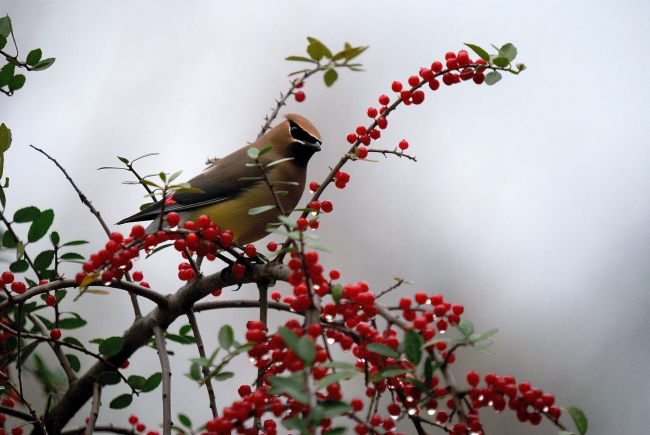
There is nothing that quite says Christmas like a holly showing out with its festive bright red berries. A specimen holly kissed by frost or draped with a blanket of snow is a sight and memory to be treasured.
After years of being mesmerized by their beauty I am now being treated to a new look at our garden in Savannah, Ga., the holly adorned with Spanish moss, looking as though they have been carefully decorated with a special tinsel of nature.
Regardless of where you live, Spanish moss or not, this is this time of the year hollies perform their magic by making the landscape so picturesque. They provide the needed evergreen structure or bones of the landscape. Without them, the garden looks a little more like the frozen tundra. The uncountable red berries are not only reminiscent of tiny ornaments but are an unbelievable source of food for hungry birds.
Consider the American holly, known botanically as Ilex opaca. It is native over a huge area of North America covering some 27 states. It can reach stately tree proportions of 30 to 60 feet in height and feeds 18 species of birds. You will find when it comes to the backyard wildlife habitat hollies are considered among the true champions.
In the landscape, the holly can perform just about any task that is needed. When privacy is needed, the first thought to come to the mind of many homeowners is a fence, which can serve the purpose if really needed. Unless you need to keep something out consider if a cluster of hollies would afford the needed screen.
At the Coastal Georgia Botanical Gardens we have used hollies in a variety of ways. There is a group of Mary Nell hollies separating our parking from our conference center. This not only provides the needed screen but also serves as the perfect evergreen backdrop for seasonal color.
In the camellia garden, we have used Robin, one of the Red Holly hybrids, in specimen plantings. With almost perfect Christmas tree structure they are a great companion to the nearby showy camellia blossoms. In the rose garden with a tiered fountain, we have used Oak Leaf, another of the Red Holly hybrids in what might best be described as specimen-type anchors.
The Red Holly hybrids made their debut in the late 1990’s and have quickly caught on with their conical or pyramidal structure, red berries and foliage that is considered the prettiest in the market. These are generally cold hardy from zones 6-9 and are sorter in stature reaching in the 10 to 14 foot range. Festive and Little Red are two others that I have grown, and rank high in among my favorite hollies.
The most famous holly in the garden is known as Lord’s holly and is known botanically as Ilex rotunda. It is the first plant I show visitors. It was no doubt planted during our plant introduction era, what many consider our country’s greatest plant exploration period. It is very old and monolithic in size, it has pendulous branches with berries totaling in the millions. Its structure today is perfect for climbing or even building a treehouse.
The word holly is believed to be derived from the word holy, for in several parts of Europe sprigs were used in decorating to commemorate the birth of Christ. Today our holiday season would not be complete without decorative holly swags on the fireplace mantle or draped along a banister, and for sure artistically placed in the table centerpiece. First, you must have them in your landscape. If you are lacking, put the holly high on your list for spring planting.
By Norman Winter
(McClatchy-Tribune News Service)
(MCT Information Services)
After years of being mesmerized by their beauty I am now being treated to a new look at our garden in Savannah, Ga., the holly adorned with Spanish moss, looking as though they have been carefully decorated with a special tinsel of nature.
Regardless of where you live, Spanish moss or not, this is this time of the year hollies perform their magic by making the landscape so picturesque. They provide the needed evergreen structure or bones of the landscape. Without them, the garden looks a little more like the frozen tundra. The uncountable red berries are not only reminiscent of tiny ornaments but are an unbelievable source of food for hungry birds.
Consider the American holly, known botanically as Ilex opaca. It is native over a huge area of North America covering some 27 states. It can reach stately tree proportions of 30 to 60 feet in height and feeds 18 species of birds. You will find when it comes to the backyard wildlife habitat hollies are considered among the true champions.
In the landscape, the holly can perform just about any task that is needed. When privacy is needed, the first thought to come to the mind of many homeowners is a fence, which can serve the purpose if really needed. Unless you need to keep something out consider if a cluster of hollies would afford the needed screen.
At the Coastal Georgia Botanical Gardens we have used hollies in a variety of ways. There is a group of Mary Nell hollies separating our parking from our conference center. This not only provides the needed screen but also serves as the perfect evergreen backdrop for seasonal color.
In the camellia garden, we have used Robin, one of the Red Holly hybrids, in specimen plantings. With almost perfect Christmas tree structure they are a great companion to the nearby showy camellia blossoms. In the rose garden with a tiered fountain, we have used Oak Leaf, another of the Red Holly hybrids in what might best be described as specimen-type anchors.
The Red Holly hybrids made their debut in the late 1990’s and have quickly caught on with their conical or pyramidal structure, red berries and foliage that is considered the prettiest in the market. These are generally cold hardy from zones 6-9 and are sorter in stature reaching in the 10 to 14 foot range. Festive and Little Red are two others that I have grown, and rank high in among my favorite hollies.
The most famous holly in the garden is known as Lord’s holly and is known botanically as Ilex rotunda. It is the first plant I show visitors. It was no doubt planted during our plant introduction era, what many consider our country’s greatest plant exploration period. It is very old and monolithic in size, it has pendulous branches with berries totaling in the millions. Its structure today is perfect for climbing or even building a treehouse.
The word holly is believed to be derived from the word holy, for in several parts of Europe sprigs were used in decorating to commemorate the birth of Christ. Today our holiday season would not be complete without decorative holly swags on the fireplace mantle or draped along a banister, and for sure artistically placed in the table centerpiece. First, you must have them in your landscape. If you are lacking, put the holly high on your list for spring planting.
By Norman Winter
(McClatchy-Tribune News Service)
(MCT Information Services)
-
Articles by Korea Herald











![[Hello India] Hyundai Motor vows to boost 'clean mobility' in India](http://res.heraldm.com/phpwas/restmb_idxmake.php?idx=644&simg=/content/image/2024/04/25/20240425050672_0.jpg&u=)








